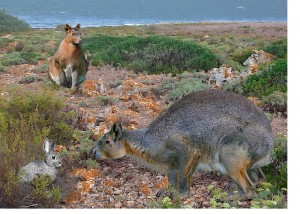SATURDAY, 23 APRIL 2011
 Bones from the fossil were found in rock formations dating back approximately three million years. The giant creature, now extinct, is expected to have weighed around 12kg, which is six times larger than modern European rabbits. N. rex had an unusual body shape for a rabbit: a stiff spine, short dumpy legs, and a small lung volume. These features mean that it was almost certainly unable to hop and would have been a slow and clumsy walker. Big floppy ears are an iconic feature of rabbits, but N. rex had relatively small eyes and ears for its size [1]. Because there were no large predators on Minorca, it had no need for highly developed powers of sight and hearing.
Bones from the fossil were found in rock formations dating back approximately three million years. The giant creature, now extinct, is expected to have weighed around 12kg, which is six times larger than modern European rabbits. N. rex had an unusual body shape for a rabbit: a stiff spine, short dumpy legs, and a small lung volume. These features mean that it was almost certainly unable to hop and would have been a slow and clumsy walker. Big floppy ears are an iconic feature of rabbits, but N. rex had relatively small eyes and ears for its size [1]. Because there were no large predators on Minorca, it had no need for highly developed powers of sight and hearing.The ‘island principle’ states that species isolated on islands often evolve into much larger or smaller versions than their mainland relatives. Although the evolutionary processes that drive these changes are still debated, one theory suggests that a lack of resources on an island can cause a tendency towards small size, whereas a lack of predators can cause island gigantism. In this case, N. rex became the largest member of the lagomorpha, the taxonomic group that includes rabbits, hares and pikas, that has ever been found.
Interestingly another island rabbit species, the Japanese Ryukyu (Pentalagus furnessi), has similar features to N. rex, although not as pronounced. It is not clear why the Minorcan giant rabbit eventually became extinct.
Written by Emma Hatton-Ellis
